Wikipedia:WikiProject QRpedia/user guide
QRpedia basics
[edit] Create
Create
[edit]- Find the Wikipedia article you want to link to.
- Copy its URL.
- Go to http://qrpedia.org. (Note: Any other QR code generator will not produce the multi-language options.)
- Paste the URL into the box. (The code will automatically generate.)
 Edit
Edit
[edit]- Click on the QR code image and save it.
- Import the QR code image into a word processor programme or graphics package.
- (Optionally) Add text labels.
 Print
Print
[edit]- Print the code a minimum of 1 inch (2.5 cm) across, where possible 2 inches (5 cm).
- Alternatively, open the downloaded images in a program that can print several images at once, as thumbnails (e.g. Windows Photo Viewer).
 Finally
Finally
[edit]- Display it in a suitable location (see below).
- Test that it works and takes you to the expected page.
- Add {{WikiProject QRpedia|article=yes}} to the article talk page.
- Drop a note on the project talk page to tell us of your success!
- For additional information, see the QRpedia Wikipedia article.
Display considerations
[edit]- If possible, providing free Wi-Fi hotspots will facilitate more use of the codes, especially in remote or thick-walled buildings with unreliable mobile internet connections.
- Display the codes where people (including children, and those in wheelchairs) can reach them.
- The codes should be well lit. Shadow makes it more difficult to scan.
- Avoid reflected glare (particularly when laminating the codes or placing them behind glass).
- Larger codes will scan more effectively. 2 inches (5 cm) across will allow for distance and older smartphones with lower quality cameras. 1 inch (2.5 cm) should be the minimum.
- Trademark agreements from the Wikimedia Foundation are required to use the Wikimedia trademarks including the Logo of Wikipedia. As of March 2013, the Foundation have indicated that no further agreements will be made for QR code projects.
Display methods
[edit]You can display QRpedia codes in a number of ways...
-
Make clear where the code will lead, by adding the article title (if likely to be recognised in multiple languages) and the word "Wikipedia". This one was printed quarter-A4 size (i.e. four to a page).
-
Or you can go for big and bold, like The Children's Museum of Indianapolis did.
-
However, if you do display codes without explanatory text...
-
...then we recommend that you display explanatory text at suitable locations.
-
Codes can also be baked onto ceramic plaques, for outdoor use.
-
Professional printers can produce other media like these glass stickers. Note the use of multiple codes; in such cases, clear labelling is vital.
-
This code uses laminated paper, in a steel holder meant for plant labels in a botanical garden.
-
An enamel plaque.
API
[edit]There is no QRpedia API, but you can use, say, the Google QR code API (other QR code APIs exist) to generate a code with the relevant qrwp.org short URL. for example:
or:
Note the use of underscores in the latter; and that you can use any two-letter language code ("en, "sv", etc.) so long as the article exists in that language, and the title given is from that language Wikipedia; so use:
or:
but not:
Advanced
[edit]It is possible to generate your own, downloadable QRpedia code images programmatically, by minting a URL in the form:
Note that you can amend some parameters. |size= is the dimension of the (square) image in pixels. |e= is the error correction rate. This has four options:
- L = Low (default)
- M = Medium
- Q = Quartile
- H = High
The higher the value, the greater the redundancy that is included in the code, allowing it to be read even if dirty or damaged. Use higher values for codes that will be displayed outdoors, in vulnerable locations. See QR code#Error correction for more.








